中考英语阅读理解题型分析
- 格式:doc
- 大小:540.00 KB
- 文档页数:50
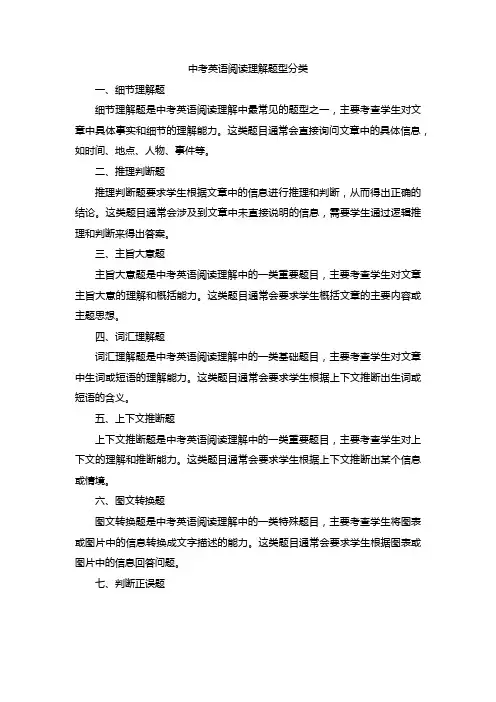
中考英语阅读理解题型分类一、细节理解题细节理解题是中考英语阅读理解中最常见的题型之一,主要考查学生对文章中具体事实和细节的理解能力。
这类题目通常会直接询问文章中的具体信息,如时间、地点、人物、事件等。
二、推理判断题推理判断题要求学生根据文章中的信息进行推理和判断,从而得出正确的结论。
这类题目通常会涉及到文章中未直接说明的信息,需要学生通过逻辑推理和判断来得出答案。
三、主旨大意题主旨大意题是中考英语阅读理解中的一类重要题目,主要考查学生对文章主旨大意的理解和概括能力。
这类题目通常会要求学生概括文章的主要内容或主题思想。
四、词汇理解题词汇理解题是中考英语阅读理解中的一类基础题目,主要考查学生对文章中生词或短语的理解能力。
这类题目通常会要求学生根据上下文推断出生词或短语的含义。
五、上下文推断题上下文推断题是中考英语阅读理解中的一类重要题目,主要考查学生对上下文的理解和推断能力。
这类题目通常会要求学生根据上下文推断出某个信息或情境。
六、图文转换题图文转换题是中考英语阅读理解中的一类特殊题目,主要考查学生将图表或图片中的信息转换成文字描述的能力。
这类题目通常会要求学生根据图表或图片中的信息回答问题。
七、判断正误题判断正误题是中考英语阅读理解中的一类重要题目,主要考查学生对文章中信息真假的判断能力。
这类题目通常会给出几个陈述或信息,要求学生判断其中的真伪。
八、选择最佳标题题选择最佳标题题是中考英语阅读理解中的一类重要题目,主要考查学生对文章主题和内容的理解和概括能力。
这类题目通常会给出几个选项作为文章的标题,要求学生选择最符合文章内容的标题。
九、匹配信息题匹配信息题是中考英语阅读理解中的一类特殊题目,主要考查学生从文章中获取信息并匹配对应选项的能力。
这类题目通常会给出多个选项和文章中的信息,要求学生匹配出正确的选项。
十、排序题排序题是中考英语阅读理解中的一类特殊题目,主要考查学生对文章中事件或信息的排序能力。
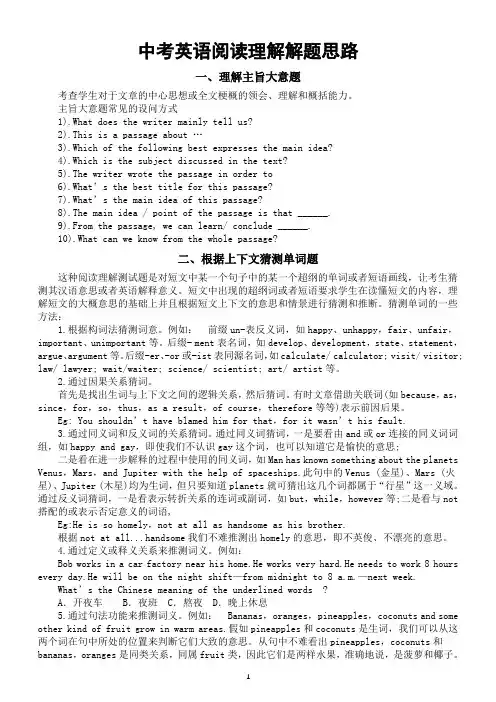
中考英语阅读理解解题思路一、理解主旨大意题考查学生对于文章的中心思想或全文梗概的领会、理解和概括能力。
主旨大意题常见的设问方式1).What does the writer mainly tell us?2).This is a passage about …3).Which of the following best expresses the main idea?4).Which is the subject discussed in the text?5).The writer wrote the passage in order to6).What’s the best title for this passage?7).What’s the main idea of this passage?8).The main idea / point of the passage is that ______.9).From the passage, we can learn/ conclude ______.10).What can we know from the whole passage?二、根据上下文猜测单词题这种阅读理解测试题是对短文中某一个句子中的某一个超纲的单词或者短语画线,让考生猜测其汉语意思或者英语解释意义。
短文中出现的超纲词或者短语要求学生在读懂短文的内容,理解短文的大概意思的基础上并且根据短文上下文的意思和情景进行猜测和推断。
猜测单词的一些方法:1.根据构词法猜测词意。
例如:前缀un-表反义词,如happy、unhappy,fair、unfair,important、unimportant等。
后缀- ment表名词,如develop、development,state、statement,argue、argument等。
后缀-er、-or或-ist表同源名词,如calculate/ calculator; visit/ visitor; law/ lawyer; wait/waiter; science/ scientist; art/ artist等。

中考英语阅读题型分类阅读对于学生来说是英语考试中非常重要的一部分,考察学生的阅读理解能力。
中考英语阅读题型主要分为四种:选择题、判断题、填空题和短文填词。
下面将对这四种题型进行详细解析。
一、选择题选择题是英语阅读题型中最常见的一种。
在选择题中,学生需要根据所给的短文或问题,从A、B、C、D四个选项中选择正确的答案。
解题技巧:1. 仔细阅读问题和选项,抓住关键词。
2. 注意选项中的关联词和转折词。
3. 排除错误答案,留下正确答案。
例如:阅读下面的短文,回答问题。
Lily is a 10-year-old girl. She is very interested in animals. She enjoys reading books about animals and watching animal documentaries on TV. She wants to become a veterinarian when she grows up. Last summer, Lily went to a zoo with her parents. She saw many different kinds of animals. Her favorite animal is the tiger. She thinks tigers are beautiful and powerful.1. What is Lily interested in?A. SportsB. MusicC. AnimalsD. Computers二、判断题判断题是中考英语阅读题型中另一种常见的题型。
在判断题中,学生需要根据所给的短文或问题,判断正误。
解题技巧:1. 仔细阅读问题和短文,抓住关键信息。
2. 注意选项中的否定词。
3. 排除错误答案,选择正确答案。
例如:阅读下面的句子,判断正误。
Tom is a student. He is eleven years old. He lives in London. He enjoys playing basketball and swimming.1. Tom is twelve years old. ()2. Tom lives in Paris. ()三、填空题填空题是中考英语阅读题型中需要学生填写单词或短语的题型。
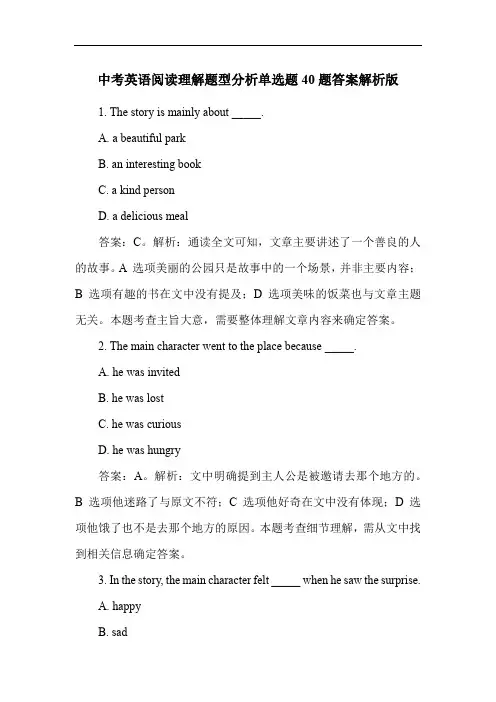
中考英语阅读理解题型分析单选题40题答案解析版1. The story is mainly about _____.A. a beautiful parkB. an interesting bookC. a kind personD. a delicious meal答案:C。
解析:通读全文可知,文章主要讲述了一个善良的人的故事。
A 选项美丽的公园只是故事中的一个场景,并非主要内容;B 选项有趣的书在文中没有提及;D 选项美味的饭菜也与文章主题无关。
本题考查主旨大意,需要整体理解文章内容来确定答案。
2. The main character went to the place because _____.A. he was invitedB. he was lostC. he was curiousD. he was hungry答案:A。
解析:文中明确提到主人公是被邀请去那个地方的。
B 选项他迷路了与原文不符;C 选项他好奇在文中没有体现;D 选项他饿了也不是去那个地方的原因。
本题考查细节理解,需从文中找到相关信息确定答案。
3. In the story, the main character felt _____ when he saw the surprise.A. happyB. sadC. angryD. surprised答案:A。
解析:根据文章内容,主人公看到惊喜时感到很开心。
B 选项悲伤不符合情境;C 选项生气在文中未体现;D 选项惊讶不是主人公的感受,而是他看到的状态。
本题考查细节理解和推理判断,需结合上下文理解主人公的感受。
4. What did the main character do first when he arrived?A. Looked around.B. Said hello.C. Sat down.D. Opened the door.答案:B。
解析:文中提到主人公到达后先打招呼。

《2025中考英语题型分析》一、协议关键信息1、中考英语考试年份:2025 年2、题型种类及数量听力理解:具体数量阅读理解:具体数量书面表达:具体数量语法填空:具体数量完形填空:具体数量单词拼写:具体数量口语表达(如有):具体数量3、各题型分值分布听力理解:分值阅读理解:分值书面表达:分值语法填空:分值完形填空:分值单词拼写:分值口语表达(如有):分值4、考试时间:具体时长11 听力理解题型分析111 听力材料的主题范围日常生活学校生活社会热点文化艺术112 题型设置听对话选择答案听短文填空听长对话回答问题113 难度级别基础理解细节把握推理判断114 应对策略日常多听英语材料,如英语广播、电影、歌曲等进行针对性的听力训练,熟悉不同题型培养快速捕捉关键信息的能力12 阅读理解题型分析121 阅读材料的类型记叙文说明文议论文应用文122 题目形式主旨大意题细节理解题推理判断题词义猜测题123 难度层次容易中等较难124 解题技巧先浏览题目,带着问题读文章学会快速定位关键信息积累常见词汇和短语,提高阅读速度注意文章的逻辑结构和段落主旨13 书面表达题型分析131 写作主题人物描写事件叙述观点阐述书信写作132 字数要求具体字数133 评分标准内容完整语法正确词汇丰富逻辑清晰134 提高方法多读优秀范文,积累好词好句定期进行写作练习,并请教老师批改注意书写规范和标点使用14 语法填空题型分析141 考查的语法点时态语态非谓语动词名词单复数形容词副词比较级最高级介词冠词等142 填空形式给出单词,用适当形式填空纯空格填词143 解题思路分析句子结构,确定语法成分结合语境,选择合适的语法形式检查答案,确保语法正确、语义通顺15 完形填空题型分析151 文章题材故事类科普类文化类152 选项特点近义词辨析固定搭配语境理解153 难度因素生词量上下文逻辑关系复杂程度154 答题技巧通读全文,掌握大意逐个击破,结合选项和上下文选择复查答案,确保连贯性16 单词拼写题型分析161 考查范围课本重点单词常见易错单词162 拼写要求正确书写注意单词的变形163 复习方法制定单词背诵计划,定期复习制作单词卡片,加强记忆通过造句练习单词的运用17 口语表达题型分析(如有)171 考查形式对话交流话题演讲172 评分要点发音准确表达流畅语法无误内容充实173 训练建议模仿标准发音,纠正口音参加英语口语活动,锻炼实战能力积累常用口语表达,丰富语言素材以上是对 2025 中考英语题型的详细分析,希望能对考生的备考有所帮助。

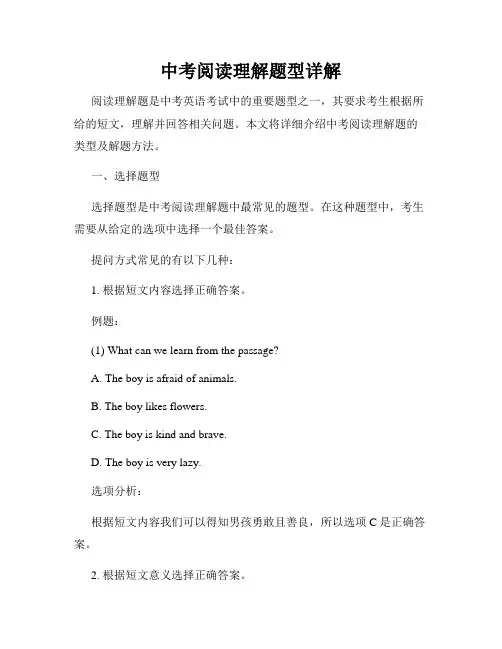
中考阅读理解题型详解阅读理解题是中考英语考试中的重要题型之一,其要求考生根据所给的短文,理解并回答相关问题。
本文将详细介绍中考阅读理解题的类型及解题方法。
一、选择题型选择题型是中考阅读理解题中最常见的题型。
在这种题型中,考生需要从给定的选项中选择一个最佳答案。
提问方式常见的有以下几种:1. 根据短文内容选择正确答案。
例题:(1) What can we learn from the passage?A. The boy is afraid of animals.B. The boy likes flowers.C. The boy is kind and brave.D. The boy is very lazy.选项分析:根据短文内容我们可以得知男孩勇敢且善良,所以选项C是正确答案。
2. 根据短文意义选择正确答案。
例题:(2) What does the underlined word "brave" mean in the passage?A. Angry.B. Happy.C. Smart.D. Courageous.选项分析:根据上下文,我们可以推断出"brave"的意思是“勇敢的”,所以答案选项D是正确答案。
解题技巧:在解决选择题时,考生需要仔细阅读题干和选项,理解短文内容,将答案与选项进行逐一比较,排除干扰项,选择正确答案。
二、配对题型配对题型要求考生根据短文内容,将相应的选项与相关信息进行匹配。
提问方式常见的有以下几种:1.根据信息选择正确答案。
例题:(3) Which of the following is true about Kate?A. She is good at math.B. She likes playing basketball.C. She has a brother and a sister.D. She enjoys dancing and singing.选项分析:根据短文内容我们可以得知Kate擅长数学,所以选项A是正确答案。
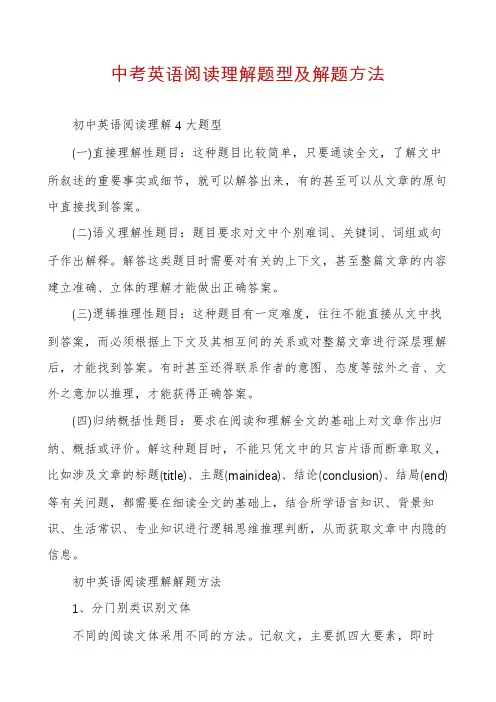
中考英语阅读理解题型及解题方法初中英语阅读理解4大题型(一)直接理解性题目:这种题目比较简单,只要通读全文,了解文中所叙述的重要事实或细节,就可以解答出来,有的甚至可以从文章的原句中直接找到答案。
(二)语义理解性题目:题目要求对文中个别难词、关键词、词组或句子作出解释。
解答这类题目时需要对有关的上下文,甚至整篇文章的内容建立准确、立体的理解才能做出正确答案。
(三)逻辑推理性题目:这种题目有一定难度,往往不能直接从文中找到答案,而必须根据上下文及其相互间的关系或对整篇文章进行深层理解后,才能找到答案。
有时甚至还得联系作者的意图、态度等弦外之音、文外之意加以推理,才能获得正确答案。
(四)归纳概括性题目:要求在阅读和理解全文的基础上对文章作出归纳、概括或评价。
解这种题目时,不能只凭文中的只言片语而断章取义,比如涉及文章的标题(title)、主题(mainidea)、结论(conclusion)、结局(end)等有关问题,都需要在细读全文的基础上,结合所学语言知识、背景知识、生活常识、专业知识进行逻辑思维推理判断,从而获取文章中内隐的信息。
初中英语阅读理解解题方法1、分门别类识别文体不同的阅读文体采用不同的方法。
记叙文,主要抓四大要素,即时间、地点、人物和事件的起因、发展和结果,从中分析他们的思想品质、性格特征等;议论文必须正确把握文章的论点和论据,理清论证思路,再进行逻辑推理得出结论;应用文其形式多样,题材各异,对这类文体的阅读应简明扼要地抓住所需信息,理解文章内容。
2、统览全篇摘录要点阅读理解是对整个文章的目的、意图、观点、立场、态度以及内在的逻辑关系的理解,统览全篇和问题找出提供信息或暗示的文章细节部分。
3、开动脑筋推测词意初中英语学科教学基本要求规定,学生应能根据上下文及构词法推测词义,旨在使学生的知识内化,同时运用知识和生活经验及逻辑推理去理解短文。
4、条分缕析理解长句在实际考试中,长句是初中生阅读理解的难点之一,对于这类句子要分清主次,先找出句子的主、谓、宾、定、状、补,再找出修饰它的从句或短语等。
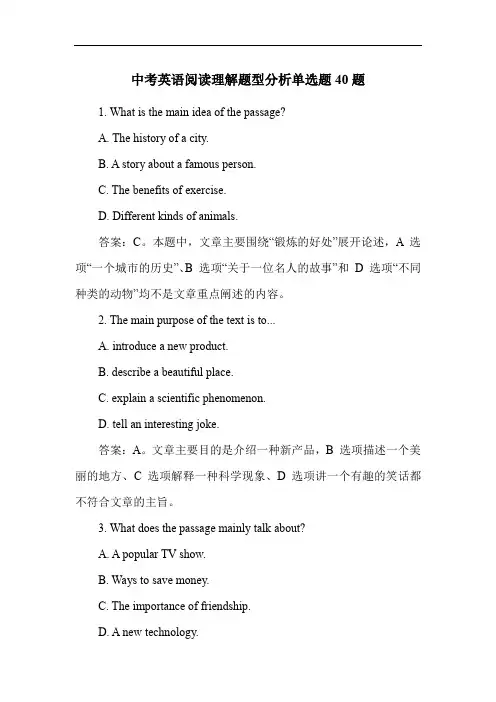
中考英语阅读理解题型分析单选题40题1. What is the main idea of the passage?A. The history of a city.B. A story about a famous person.C. The benefits of exercise.D. Different kinds of animals.答案:C。
本题中,文章主要围绕“锻炼的好处”展开论述,A 选项“一个城市的历史”、B 选项“关于一位名人的故事”和D 选项“不同种类的动物”均不是文章重点阐述的内容。
2. The main purpose of the text is to...A. introduce a new product.B. describe a beautiful place.C. explain a scientific phenomenon.D. tell an interesting joke.答案:A。
文章主要目的是介绍一种新产品,B 选项描述一个美丽的地方、C 选项解释一种科学现象、D 选项讲一个有趣的笑话都不符合文章的主旨。
3. What does the passage mainly talk about?A. A popular TV show.B. Ways to save money.C. The importance of friendship.D. A new technology.答案:B。
文章重点讲述的是省钱的方法,A 选项“一个受欢迎的电视节目”、C 选项“友谊的重要性”和D 选项“一项新技术”并非文章的主要内容。
4. The main topic of this passage is...A. A famous artist.B. Healthy eating habits.C. Travel experiences.D. The history of music.答案:B。
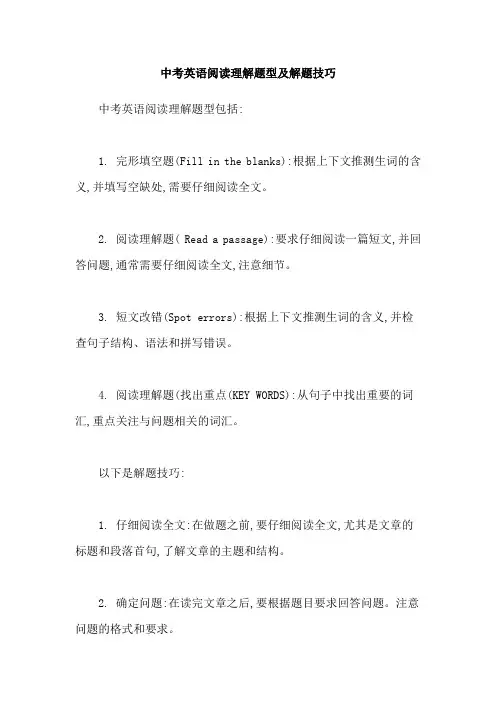
中考英语阅读理解题型及解题技巧
中考英语阅读理解题型包括:
1. 完形填空题(Fill in the blanks):根据上下文推测生词的含义,并填写空缺处,需要仔细阅读全文。
2. 阅读理解题( Read a passage):要求仔细阅读一篇短文,并回答问题,通常需要仔细阅读全文,注意细节。
3. 短文改错(Spot errors):根据上下文推测生词的含义,并检查句子结构、语法和拼写错误。
4. 阅读理解题(找出重点(KEY WORDS):从句子中找出重要的词汇,重点关注与问题相关的词汇。
以下是解题技巧:
1. 仔细阅读全文:在做题之前,要仔细阅读全文,尤其是文章的标题和段落首句,了解文章的主题和结构。
2. 确定问题:在读完文章之后,要根据题目要求回答问题。
注意问题的格式和要求。
3. 定位信息:在阅读文章时,要找到与问题相关的信息,一般来说,信息出现的位置比较固定,如标题、段落首句、段落中和题目中。
4. 利用上下文:在回答问题时,要根据上下文推断问题的含义。
同时,上下文也可以帮助判断选项是否正确。
5. 排除错误选项:在比较选项时,要排除与问题不相关的选项,
重点关注与问题相关的选项。
6. 练习做题:多做练习题,可以提高做题速度和准确性。
同时,
也可以利用一些解题技巧和策略,如预测、推断、比较等。

中考阅读理解常见题型中考阅读理解是中考英语考试的重点内容之一。
常见的阅读理解题型包括:主旨大意题、细节题、推理题和判断题。
本文将针对这些题型进行介绍和解析。
一、主旨大意题主旨大意题是要求读者从整篇文章中抓住作者的中心思想或文章的主要观点。
在解答这类题目时,考生需要通读文章,理解每一段的意思,并综合各段意思,确立文章的中心思想。
一般来说,主旨大意题的答案往往可以在文章的开头或结尾找到,也有可能需要通过推理或细节进行判断。
二、细节题细节题是要求考生根据文章中的具体细节信息进行判断。
在解答这类题目时,考生需要仔细阅读文章,找出问题所涉及的地方,将问题与文章进行对应,找出正确答案。
三、推理题推理题是要求考生根据文章中所提供的信息进行合理推断或判断。
在解答这类题目时,考生需要根据已有的信息进行推理,找出最符合逻辑的选项。
推理题有时会提供一些线索,但有时也需要考生进行自己的猜测和推断。
四、判断题判断题是要求考生根据文章中的陈述进行判断真假。
在解答这类题目时,考生需要根据所给的陈述,结合文章内容进行判断。
判断题往往需要考生对文章内容有较强的理解能力和判断能力。
五、解题技巧1. 通读全文:在回答阅读理解题之前,首先对整篇文章进行通读,了解文章的大意和结构,为后续的解题做好铺垫。
2. 标记关键词:在阅读文章的过程中,可以用笔在文章中划出关键词或关键句,以便在解题时能够快速定位。
3. 注意词义转换:有时在阅读理解题中,文章中的一些词汇可能会进行词义的转换,考生需要注意词义变化,以免误解。
4. 考虑逻辑关系:在阅读理解题中,往往会涉及到逻辑关系,考生需要通过理解文章的逻辑关系,来判断问题的答案。
常见的逻辑关系有因果关系、转折关系、并列关系等。
总结:阅读理解是中考英语考试中的重要内容,考生在备考过程中要多进行阅读练习,掌握不同题型的解题技巧,并在考试中注重细节,正确理解文章内容,以提高解题的准确性和速度。
通过不断的练习和积累,相信考生在中考英语阅读理解中能够取得好成绩。
中考英语阅读理解题型分析阅读理解是中考英语试卷中的重要部分,通过阅读理解题可以考察学生的阅读能力、理解能力和推理能力。
本文将对中考英语试卷中的阅读理解题型进行详细分析。
一、题型分类1. 阅读短文选择题这种题型要求考生根据短文内容回答问题或选择正确的选项。
通常会提供一个短文和几个问题或选项,考生需要根据短文细节或推理理解来回答问题。
这种题型的难点在于考生要全面理解短文,抓住关键信息。
例题:Mr. Smith is a teacher. He has a son. He's a student in a middle school. His name is John. John is a good boy. He likes English and math. He likes playing table tennis, too. He often plays table tennis after school. He is in the table tennis club of his school. He is good at playing table tennis. His mother is a doctor. She is a busy woman. She likes her work very much. She has no time to play table tennis with John. Mr. Smith often plays table tennis with him. They are good at playing table tennis.According to the passage, who often plays table tennis with John?A. His father.B. His mother.C. His teacher.D. His friends.2. 判断正误题这种题型要求考生判断给出的陈述是否与短文内容相符。
中考英语阅读理解题型及解题技巧一、常见题型及解题技巧根据历年来全国各地中考阅读理解题型的分析,将阅读理解题大致归纳为以下四类:(一)细节理解题一般针对某个特定的细节而提供,难度较小,属表层信息理解,考生通读短文后可直接找出答案依据。
解题技巧:通读短文,领会文章大意,理解文章结构层次及细节,特别注意:1. 五个W (who ,which ,when ,where ,what )和一个H (how );2. 数字、日期、时间等;3. 注意加强语气的词。
然后运用排除法排除不符合原文细节的选项,剩下的就是要选择的最佳答案。
(二)词句理解题此题要求考生正确理解短文中的一些关键词语或句子的含义,常用的方法是多种表达法、一词多义法、同义近义或反义提示法、习语释文法及句型转换法等。
解题技巧:1. 正确理解题意,从短文中找到相关的词、短语或句子,根据特定的语境来判断理解,推敲斟酌和最后确定其准确含义。
2. 根据上下文猜测词义的技巧:(1)注意定义和解释;(2)同义词或近义词的提示;(3)近义词和反义词的提示;(4)利用悬念的属种关系;(5)借助已有知识或生活常识。
(三)推理判断题通过字里行间的阅读,作合理的推断。
解题技巧:1. 分析文章的主旨。
2. 分清文章的主要思想及次要思想。
3. 寻找文章的逻辑思路。
4. 核对问题中各项选择与文章中有关词句的联系。
(四)归纳概括题此题主要针对文章的主题、中心思想、文章的结构层次(主题句或主题段),要求学生在理解全文后归纳短文要点,概括中心思路。
解题技巧:通读全文,了解大意,灵活运用概括、判断、归纳、推理等方法,准确理解文章的话题和中心思想。
有时还要求对作者叙述的意图和观点作进一步剖析,甚至推测作者的语气和态度等。
一般说来,文章的段落常有概括中心思想的主题句,且多位于段首或段末,有时也会夹在中间。
对无主题句的篇章,考生应对文章进行分析和归纳,然后概括中心思想。
二、答题步骤1. 先看问题,再读文章。
中考英语阅读理解常考题型及解题技巧,给孩子保存一份吧!【1】中考英语阅读理解常考题型及解题技巧1. 事实细节题通过阅读短文,可以直接从阅读材料中找到这类问题的答案,常考查的方面有事件发生的时间,地点,原因,方式,过程,结局,人物之间的关系,事件之间的关系,词和句的含义等。
事实细节题设题手段单一,常常针对文章中某个容易误解的关键词句或概念,通过移花接木的手段组成是非辨别选择题,难度较小,属浅层理解题。
事实细节题题干常见的提问形式:1)是非判断类型Which of the following is NOT mentioned in the passage? Which of the following statements is NOT true?2)特殊疑问词提问类型How many……?What/who/when/where/how/why……?3)排序题类型Which of the orders is correct according to the passage?4)例证题类型The author gives the example in……paragraph in order to ……事实细节题的解题方法:做这类题的一般方法是先要找出题干或是选项中的关键字,一般为数字、大写或人名地名,再通过scanning快速确定该细节在文中的出处(信息源),仔细对照题干要求,排除或选择。
命题者在出这类题时惯用“偷梁换柱、张冠李戴”的手法来迷惑考生,即对原句细微处做改动,截取原文词语或结构进行改造,因果倒置,把A的观点说成B 的观点等。
所以正确理解题干和信息句的意义是关键。
细节事实题还要十分注意句子的非主干成分,如定语、状语、补语等,这些成分都是出题者常进行误导的落脚点。
是非判断一般都遵循对照选项进行“三对一错或三错一对”的判断。
若该信息句是长句或难句,要学会找出其主干部分,分析句子结构,正确理解信息句的意义。
中考英语阅读理解题的分析及答题技巧阅读是语言学习的一个重要组成部分,是培养学生分析、理解、推理、判断等多方面能力的综合学习活动。
阅读能力的培养在英语教学中占有十分重要的地位,通过阅读既可获取知识,开阔视野,还能在考试中取得好成绩。
一、阅读理解题型分析阅读理解题是中考的重点测试题型,其卷面分值约占全卷的三分之一。
中考阅读理解题一般设三至五篇短文,每篇短文词汇量在250个单词左右。
从近几年的中考英语阅读理解情况来看,短文体裁多样,有记叙文、说明文、应用文、科普文、广告文、议论文等;题材各异,文章涉及科普知识、社会文化、名人轶事、历史地理、政治经济、自然环保、体育卫生和日常生活等方面,充分体现其时代性、实用性。
常见题型主要有选择题和判断正误题。
选择题根据考察方向的不同,又可分为主旨大意题、事实细节题、推理判断题、图表理解题、简单计算题、词义猜测题、常识性判断题等。
随着社会的发展及英语教学水平的提高,阅读理解题型设置的内容和难度也在逐渐加大,各地的试题中也出现了填空、回答问题、完成句子等不同形式的任务型阅读题型。
这类试题能较好地体现“考察学生运用语言‘做事’的能力,即解决生活中所遇到的实际问题的能力”的原则,旨在考察学生的阅读技能和阅读速度等。
总的来说,这类题的选题内容、命题角度、题型设置均较好,能考察学生的视读图表、提取、填补信息、正确表达的能力。
试题的设计版式也具有现实生活的真实性。
但不管采用什么样的阅读题型,中考试题都体现出共同的特征,即时代气息浓,可读性强,理解难度高,考查了学生实际运用语言的能力。
所以,考生一定要在充分了解中考阅读题型的基础上,注重科学的阅读训练,广泛地吸收阅读材料,增大语言信息的输入量,提高阅读速度,才能达到中考阅读理解的要求,顺利地完成中考阅读理解试题。
二、答题技巧要想提高阅读能力并在考试中获得高分,就有必要掌握和运用各种阅读技巧。
根据本人的教学经验,在解答阅读理解题型时,可着重采取以下四个步骤:(一)略读阅读英语文章时一定要注意培养自己快速阅读的良好习惯,改逐字逐句的点式阅读为一次扫描一句的线式阅读。
中考英语阅读理解的题型
中考英语阅读理解的题型主要包括以下几种:
1. 主旨大意题:要求考生在阅读文章后,概括出文章的主要内容或中心思想。
2. 细节理解题:要求考生根据文章中的细节信息,回答相关问题。
3. 推理判断题:要求考生根据文章的内容进行推理和判断,得出正确的结论。
4. 词汇理解题:要求考生根据文章中的语境,理解生词或短语的意思。
5. 作者观点题:要求考生根据文章中的观点和态度,判断作者的态度和意图。
6. 标题选择题:要求考生根据文章的内容和主旨,选择一个最恰当的标题。
7. 推断判断题:要求考生根据文章中的信息和线索,进行逻辑推断和判断。
8. 细节比较题:要求考生比较两个或多个细节,找出它们之间的异同点。
9. 作者态度题:要求考生根据文章中的信息,判断作者的态度和意图。
10. 主旨观点题:要求考生根据文章的内容和主旨,选
择一个最恰当的观点。
以上是中考英语阅读理解常见的题型,考生在备考中需要对这些题型进行分类和练习,以提高阅读理解能力和答题技巧。
中考英语阅读理解常考题型中考英语中,阅读理解占据着重要的地位。
它不仅考查学生的词汇量、语法知识,更考验学生的理解能力、逻辑思维和综合运用英语的能力。
了解常考题型,掌握解题技巧,对于在中考中取得优异成绩至关重要。
以下是中考英语阅读理解常见的几种题型。
一、细节理解题这是中考阅读理解中最常见的题型之一。
这类题目主要考查学生对文章具体细节的理解和把握。
题目往往会问关于时间、地点、人物、事件、原因、结果等方面的问题。
例如:“When did the story happen?” 、“Where did the main character go?” 、“Who was the first one to arrive?” 等。
解题技巧:首先,需要认真阅读题干,明确题目所问的具体内容。
然后,带着问题回到文章中,快速定位相关信息。
在寻找答案时,要注意关键词和关键句,同时要仔细对比选项与原文,确保答案的准确性。
二、主旨大意题主旨大意题要求学生理解文章的中心思想或主要内容。
这类题目通常会问:“What is the main idea of the passage?” 、“What is the passag e mainly about?” 等。
解题技巧:在阅读文章时,要注意文章的开头、结尾以及段落的首句和尾句,这些地方往往会包含文章的主旨。
同时,要对文章的整体内容进行概括和总结,排除那些过于细节或片面的选项。
三、推理判断题推理判断题需要学生根据文章所提供的信息进行推理和判断,得出合理的结论。
例如:“What can we infer from the passage?” 、“Which of the following is probably true?” 等。
解题技巧:在解答这类题目时,不能仅凭文章中的表面信息,而要深入理解文章的含义,结合自己的常识和逻辑思维进行推理。
同时,要注意选项中的表述是否过于绝对或不符合常理。
一、中考英语阅读理解汇编1.阅读短文,从每题所给的A、B、C和D四个选项中,选出最佳选项。
In many countries around the world, May 1st is a holiday which is called Labor Day or Workers' Day. It is an interesting holiday that honors working people and their jobs. But do you know how it started?During the late 1880s, in many parts of the world, people worked for fourteen to sixteen hours a day in factories, but made very little money. Later, in the United States and Canada, working people got together to set up unions (工会). The union leaders asked factory bosses for shorter working time and higher salaries (工资), but many of the bosses ▲ .On May 1st, 1886, men and women in the United States and Canada stopped working and went onto the streets. They walked through cities and towns to force bosses to let them work eight hours a day. In the city of Chicago, several people died in fighting with the police. Over the next few years, people in cities around the world stopped working on May 1st to honor workers everywhere. By the early twentieth century, the first of May became a national holiday in many countries.However, in the United States and Canada, May 1st is not a holiday. North Americans celebrate Labor Day on the first Monday in September. Today in the United States, Labor Day is mostly about having fun. People enjoy a long weekend and often celebrate it by having picnics with friends or family. In many parts of the United States, Labor Day is also the last day of summer vacation, and students return to school the next day.(1)How long did people work a day in factories in the late 1880s?A. For 8-10 hours.B. For 10-12 hours.C. For 12-14 hoursD. For 14-16 hours.(2)Which can be the best for ▲ ?A. refused their ideasB. accepted their ideasC. agreed with themD. understood them(3)What does the underlined word "force" mean?A. 感激B. 迫使C. 宣扬D. 欣赏(4)Which is the right order (顺序) of the following events?①Working people began to fight for better life.②People stopped working on May 1st to honor workers.③Working p eople set up unions.A. ①②③B. ②①③C. ③②①D.③①②(5)How do people often celebrate Labor Day in America nowadays?A. By working all day.B. By giving gifts to working people.C. By having fun with friends or family.D. By having a big ceremony.【答案】(1)D(2)A(3)B(4)D(5)C【解析】【分析】大意:本文介绍五一劳动节的由来。
(1)细节题。
根据During the late 1880s, in many parts of the world, people worked for fourteen to sixteen hours a day in factories,可知,那时的工人每天工作14到16小时,故选D (2)推断题。
根据 The union leaders asked factory bosses for shorter working time and higher salaries.和 On May 1st, 1886, men and women in the United States and Canada stopped working and went onto the streets.可知,工会领袖要求工厂老板减少工人上班时间同时增加工人工作,和下文美国和加拿大工人罢工游街,可推出工厂老板拒绝了工会提出的要求,故选A。
(3)词义猜测题。
根据 On May 1st, 1886, men and women in the United States and Canada stopped working and went onto the streets. They walked through cities and towns to force bosses to let them work eight hours a day.可知,美国和加拿大工人罢工游街逼迫老板让他们每天工作8小时,可推出force意思为迫使,故选B。
(4)细节题。
根据 working people got together to set up unions (工会). On May 1st, 1886, men and women in the United States and Canada stopped working and went onto the streets. Over the next few years, people in cities around the world stopped working on May 1st to honor workers everywhere.可知,顺序为:首先是建立了工会,然后工人为更好的生活而打架,最后是五一停工,故选D。
(5)细节题。
根据 Today in the United States, Labor Day is mostly about having fun. People enjoy a long weekend and often celebrate it by having picnics with friends or family. 可知,现在的美国和加拿大通过和家人或者朋友一起玩来庆祝五一节。
故选C。
【点评】考查阅读理解,首先通读全文,了解全文大意,其次分析问题,抓住问题的关键词,在文中寻找相关信息,确定答案,最后再检查一遍,确保答案正确。
2.阅读短文,判断下列句子正误。
Zak's grandfather, Stan was very famous. Why? Because he had a very, very, very long white beard (胡子).One day, Zak asked his grandfather, "When you sleep, do you put your beard over or under the quilt (被子)?" "I'm not sure. I never care about that," said his grandfather, "I'll look tonight." Stan got into bed that night and pulled up the quilt. Then he remembered his grandson's question. Aha! His beard was under the quilt. But wait. Did that feel right?He lift his beard from under the quilt and put it above it. This also didn't feel right. Si he put the beard under the quilt again. But he soon felt it would be better if it were out. The beard went in and out—first under the quilt, then over it, under, over, all night long.Stan spent a sleepless night. In the morning, he was so tired and unhappy that he cut his long beard right off!Stan's wife was so happy. She advised Stan to cut that beard off many times, but he never did it. Now a simple question made him do that.(1)Stan was very famous for his long white beard.(2)Stan never cared about Zak, his grandson.(3)At the very beginning, Stan's beard was under the quilt.(4)That night Stan was sleepless and tired because of the question.(5)Stan listened to his wife's advice to cut the beard off.【答案】(1)1(2)0(3)1(4)0(5)1【解析】【分析】主要讲了Zak的爷爷因为长胡子而出名,一天Zak问爷爷睡觉把胡子放在被子上面还是下面,结果爷爷放了一晚,最终把胡子剪了。